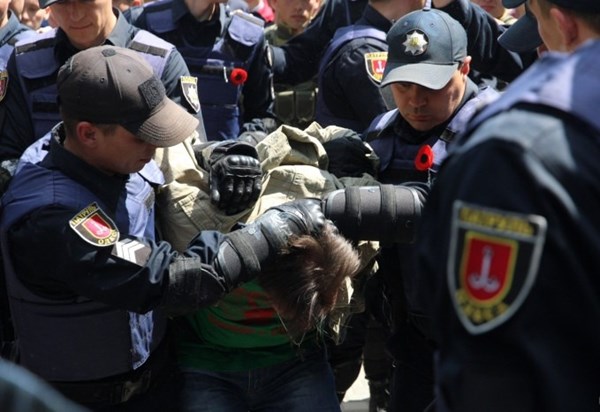Victory Day in Ukraine: massive fights and arrests
On May 9, large public events took place in Ukraine for the day of Victory over Nazism in World War II. According to provisional information, nearly 600 000 people took part in the events. However, the holiday was not without fights, wounds and arrests. The conflict was most intense in several cities.
Kyiv
According to the communication department of the National Police of Ukraine, about 30 people were arrested in Kyiv. The first clash took place when participants in the so-called “Immortal Regiment” (a pro-Russian rally) came past the office of the Organization of Ukrainian Nationalists (OUN). Law enforcement officers had cordoned off the OUN office building to prevent provocations. From the building, balls of paint, eggs, potatoes, smoke bombs and poles were dropped on police officers.
Andrey Krishchenko, chief of the National Police head office in Kyiv, said that on account of the conflict, 24 people in the OUN office in Kyiv were arrested. He also noted that another person was arrested before the start of the “Immortal Regiment” procession at Arsenalna square. Furthermore, police confiscated Soviet symbols – prohibited Georgian ribbons and red flags of the Ukrainian Communist party – from several people, mostly elderly persons. Krishchenko also added that there was no major discovery of prohibited objects. Later another six people who had resisted law enforcement and used prohibited symbols were dropped off at the police station. The chief of police pointed out further that there were no injuries during the local clashes.
Dnipro
In Dnipro there was massive fighting. The cause was the procession of the “Opposition bloc”, headed by Oleksandr Vilkul, former Vice Prime Minister during Yanukovych’s time. The news outlets 056 and Informator reported that several dozen activists and Donbas war participants demanded that the Opposition Bloc put away the Opposition bloc and USSR symbols. This led to a brawl with people of sporty build from Viklul’s entourage, resulting in several injuries. According to the Police’s information, four injured persons were given aid on the scene, the rest went to hospital. Six police officers were also injured. Two of them requested aid on account of the spraying of an unknown gas. Several participants in the encounter were hit on the head, and 15 people were arrested.
Odesa
In Odesa, law enforcement officers arrested 20 people who took part in memorial activities. Initially verbal conflict broke out between pro-Ukrainian and pro-Russian activates, and it later developed into a fistfight.
Mykolaiv
In Mykolaiv there were two demonstration processions: the first came with portraits of fighters of the Ukrainian Insurgent Army (UPA), the second with portraits of people who fought in the Soviet army. In order to avoid clashes, police representatives came between the two processions. They did not, however, manage to stop fights. Scuffles broke out between representatives of patriotic organizations and Afghanistan fighters. The clashes involved fists, pepper spray and explosive packages. Law enforcement officers reacted swiftly to the start of the fight, and managed to stop it almost immediately.
Kharkiv
In Kharkiv there were also several small fights on account of Soviet symbolism. Police reported that no one was injured, and nobody had approached law enforcement with claims. Later the police received an anonymous report about a mine being placed in Freedom Square. Hundreds of people were evacuated, but the threat proved to be fictitious.
Zaporizhia
In Zaporizhia there were scuffles near the town hall. Pro-Ukrainian activists opposed the procession of the so-called “Immortal Regiment” and blocked their passage. The efforts of 200 police officers and national guardsmen were needed to surround the participants of the pro-Russian march and escort them to the war memorial in order to lay down flowers there. The head of the patrol police was injured as a result of the encounter.
